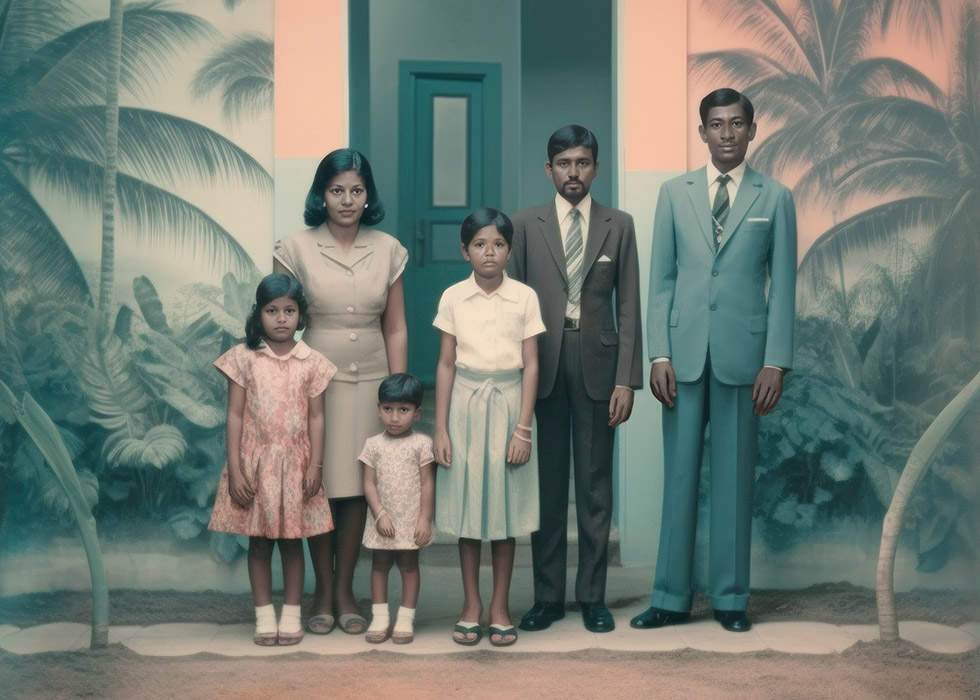In Autograph’s new major exhibition, I Still Dream of Lost Vocabularies, we’ve brought together the work of thirteen artists working with ideas of collage to explore issues of political dissent and erasure, offering new perspectives on complex histories and contested social realities.
Below, we introduce four of the key themes from the show which is free to visit at Autograph until 21 March 2026.
Connecting all thirteen of the artists whose work is on display in the exhibition is the medium of collage, in an expanded sense, incorporating archival and found imagery, cut paper, digital work, AI, textiles, painting and sculpture.
While the works are materially and conceptually different, the exhibition demonstrates what collage as both a method and a metaphor can enable, in terms of its capacity to hold multiple truths and bring together different narratives in a manner which enables us to resist the flattening of complex subject matters.
For example, in Sabrina Tirevengadum’s work, the artist uses generative AI alongside archival imagery to create digital collages which reconstruct the lost family history of her Mauritian ancestors. Meanwhile, Thato Toeba’s sculptural collage responds to the near-total absence of black Africans in the archives of British war photographer Horace Nicholls, utilising negative space to contest the notion of ‘truth’ in the photographic archive.
The subject of borders and migration is a recurrent theme throughout this exhibition. While Arpita Akhanda weaves together colonial maps with images from her family archive to consider the impact of the partition of India on her family, Sheida Soleimani’s layered tableaux draw on the migratory movements of birds to reflect on her family’s personal experiences of exile persecution and migration from Iran.
In Reena Saini Kallat’s work, Pattern Recognition, the artist takes a meticulous approach to the subject of social and political borders, documenting and indexing the different rights and privileges relating to international movement afforded to 28 different nations. Through her work, we are encouraged to understand borders not so much as physical fences or barricades but as constraints placed on individuals as a result of policy and privilege.
Forms of montage have long served as a critical tool, supporting artistic expression and a more nuanced representation of identity in relation to issues of gender and sexuality. In the exhibition, artists including Sunil Gupta, Qualeasha Wood and Kudzanai-Violet Hwami all utilise the medium of collage to reflect on both personal and collective understandings of gender. While Gupta’s works from the 90s grapple with masculinity and the boundaries between public and private life, Wood considers the present moment in which identity is continually shaped and distorted by digital culture, critiquing the coercive nature of online trends with a particular focus on women’s experiences.
Collage opens up new possibilities and enables us to bring new ideas into conversation with one another. In the exhibition, artists including Sim Chi Yin, Jess Atieno, Brook Andrew and Wendimagegn Belete use collage to challenge the idea of history as fixed, creating counter narratives that critique power structures and imagine alternative pasts, presents and futures.
As an artist of Wiradjuri, Ngunawal and Celtic heritage, Brook Andrew uses his artistic practice to highlight how Western narratives have stereotyped and marginalised Indigenous Australian voices. In his work SMASH IT, Andrew layers image and sound to challenge how colonial histories are remembered.
Meanwhile, in Chi Yin’s work, the artist inserts members of her own family into archival lantern slides depicting scenes from colonial era British Malaya (now Malaysia) and southeast Asia. Here, the archive provides a fantastical and unstable site for photographic time travel, enabling the artist to muse on issues of trauma and the long legacies of colonial violence as well as the possibilities for transgenerational memory to shape the future.

10 Oct 2025 – 21 Mar 2026
A free exhibition examining political dissent and erasure through the idea of collage
Banner image: Sabrina Tirvengadum, Family [detail], 2023.
© and courtesy the artist and Autograph, London.
Images on page: 1) Thato Toeba, Man on Fire, 2017. © and courtesy the artist. 2) Sheida Soleimani, Magistrate, 2024. From the series Flyways. © and courtesy the artist and Edel Assanti. 3) Reena Saini Kallat, Bangladesh from the series Pattern Recognition, 2022. Commissioned by Autograph, London. Supported by the Bagri Foundation. © and courtesy the artist. 4) Qualeasha Wood, A flaw in my code, 2025. © and courtesy the artist and Pippy Houldsworth Gallery. 5) Sunil Gupta, from the series Trespass, 1992-1995. Collection of Autograph, London. Commissioned by Focal Point Gallery/Essex County Council. © and courtesy the artist. 6) Sim Chi Yin, from the series The Suitcase is a little bit rotten, 2022. Commissioned by Autograph, London. Supported by the Bagri Foundation. © and courtesy the artist. 7) Wendimagegn Belete, film installation from Unveil, 2016. 22’00” minutes. © and courtesy the artist and Kristin Hjellegjerde Gallery.
Autograph is a space to see things differently. Since 1988, we have championed photography that explores issues of race, identity, representation, human rights and social justice, sharing how photographs reflect lived experiences and shape our understanding of ourselves and others.